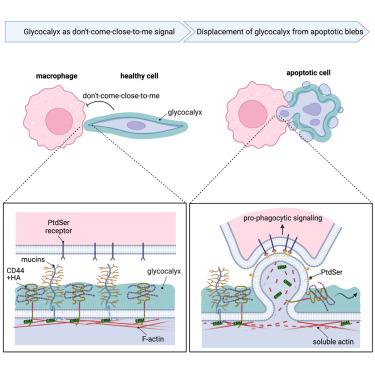Developmental Cell ( IF 11.8 ) Pub Date : 2024-02-14 , DOI: 10.1016/j.devcel.2024.01.020 Trieu Le , Iuliia Ferling , Lanhui Qiu , Clement Nabaile , Leonardo Assunção , Calvin D. Roskelley , Sergio Grinstein , Spencer A. Freeman

|
Phagocytes remove dead and dying cells by engaging “eat-me” ligands such as phosphatidylserine (PtdSer) on the surface of apoptotic targets. However, PtdSer is obscured by the bulky exofacial glycocalyx, which also exposes ligands that activate “don’t-eat-me” receptors such as Siglecs. Clearly, unshielding the juxtamembrane “eat-me” ligands is required for the successful engulfment of apoptotic cells, but the mechanisms underlying this process have not been described. Using human and murine cells, we find that apoptosis-induced retraction and weakening of the cytoskeleton that anchors transmembrane proteins cause an inhomogeneous redistribution of the glycocalyx: actin-depleted blebs emerge, lacking the glycocalyx, while the rest of the apoptotic cell body retains sufficient actin to tether the glycocalyx in place. Thus, apoptotic blebs can be engaged by phagocytes and are targeted for engulfment. Therefore, in cells with an elaborate glycocalyx, such as mucinous cancer cells, this “don’t-come-close-to-me” barrier must be removed to enable clearance by phagocytosis.
中文翻译:

糖萼的重新分布暴露了凋亡细胞的吞噬决定簇
吞噬细胞通过与凋亡靶标表面的磷脂酰丝氨酸 (PtdSer) 等“吃我”配体结合来清除死亡和垂死的细胞。然而,PtdSer 被庞大的外表面糖萼所掩盖,这也暴露了激活“别吃我”受体(如 Siglecs)的配体。显然,成功吞噬凋亡细胞需要解除近膜“吃我”配体的屏蔽,但这一过程的机制尚未被描述。使用人和鼠细胞,我们发现细胞凋亡诱导的锚定跨膜蛋白的细胞骨架的收缩和减弱导致糖萼的不均匀重新分布:出现肌动蛋白耗尽的泡,缺乏糖萼,而凋亡细胞体的其余部分保留了足够的糖萼肌动蛋白将糖萼固定到位。因此,凋亡泡可以被吞噬细胞接合并被靶向吞噬。因此,在具有复杂糖萼的细胞中,例如粘液癌细胞,必须去除这种“不要靠近我”的屏障,以便通过吞噬作用进行清除。



























 京公网安备 11010802027423号
京公网安备 11010802027423号